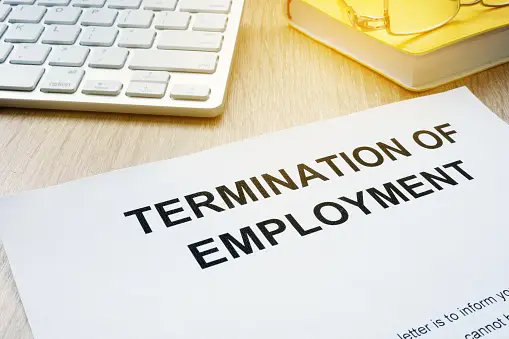
Even if you had no interest in the work and were already intending to quit, getting fired is rarely a pleasant experience. The termination would not have surprised you if you had already been subject to several disciplinary measures or were on probation. But not every firing has a valid reason. Let’s check what the wrong termination means and how to pursue it.
What Qualifies as an Unfair Termination?
In Canada, getting fired is okay if you messed up, but if the company lets you go without fault (downsizing, finances), they legally owe you something like a heads-up (notice) or money (severance) for losing your job. If they fire you without fault and skip this step, that’s wrongful termination, basically letting you go unfairly. Here are some common illegal reasons for termination and how to protect your rights.
-
Discrimination
It is unlawful to fire a worker on the grounds of discrimination. Discrimination may occur based on national origin, disability, race, gender, age, religion, or other protected traits. For example, after a female employee discloses her pregnancy, her employer terminates her, alleging unspecified performance difficulties.
Even if the older workers perform well, the employer fires them and hires a younger person in their place.
-
Intimidation
Employees who participate in constitutionally protected activities cannot be fired by their employers in retribution. This includes documenting infractions related to workplace safety, submitting a discrimination complaint, or taking part in an employer inquiry. For example:
After informing the Occupational Health and Safety Administration (OSHA) about hazardous working circumstances, an employee gets fired for a spurious or false cause very soon after. After reporting a supervisor for sexual harassment, an employee is dismissed without cause and without warning for allegedly performing poorly.
So, it is against the law for employers to take adverse action against workers who report workplace hazards and safety standards.
-
Employment Contract Violation
It may be wrongful termination if an employer breaches the terms specified in an employment contract that govern when an employee may leave. For example, consider:
- An employee is terminated for a small infringement not covered by their contract, despite a contract stating they can only be fired for particular reasons, such as serious misbehaviour.
- An employer fires a worker without giving them the notice time or severance compensation that was agreed upon, or without following the processes specified in the employment contract.
-
Positive Rejection
When an employer creates working circumstances so bad that an employee feels compelled to quit, this is known as a constructive dismissal. This can be regarded as an instance of unjust termination. For example,
- To compel an employee to resign, they may be demoted without cause, given drastically fewer duties, or transferred to an unfavourable office location.
- When an employee has unjustifiable working conditions or persistent harassment from their company, they eventually quit.
-
Violating Public Policy
It is also unlawful termination when an employee is fired for reasons that are against public policy. This involves firing a worker for using their legal or civic obligations or for exercising their rights. For example,
- When an employee is fired for exercising a legally protected civic duty — taking time off work to serve on a jury.
- When a worker refuses to take part in unlawful activity, including falsifying company records.
How to Handle a Wrongful Termination?

How to pursue a wrongful termination lawsuit?
-
Understand What Constitutes Wrongful Termination
Before seeking legal help, it’s critical to understand the examples of wrongful termination. You already know them since we mentioned most of them. As a quick summary, you can understand that you were fired unfairly, when:
- Being discriminated against due to factors beyond your control, such as your age, religion, or colour.
- Penalizing you for doing the right thing, such as reporting workplace safety violations.
- There may be an issue if your employment contract specifies that you can only be fired for specific reasons and you are fired for an unspecified cause.
- If your supervisor consistently fosters a toxic work atmosphere and presses you to leave, making your job unbearable.
-
Consult with an Employment Lawyer
Filing a wrongful termination case involves many steps, one of which is to consult with an employment lawyer who specializes in employment law. A lawyer may help determine your case’s merits, provide legal advice, and defend you throughout the process.
They will define the possible results, clarify your legal rights, and offer professional legal advice on the best course of action. To make sure that your case is presented successfully and that you have the greatest legal help available, your legal professional will represent you throughout the process in negotiations, mediation, and court processes.
-
Gather Evidence
Building a strong case requires substantial evidence. Collect all relevant documents and communications, including:
- Employment Contracts: These set out the conditions of your employment, including terms of termination.
- Termination Notices: Records from your employer outlining the grounds for your termination.
- Emails and Correspondence: Any written exchanges that provide information about the reasons for your termination with your company.
- Performance Reviews: These can demonstrate your effectiveness at work and disprove any allegations of subpar work that are used as justification for dismissal.
- Statements from Witnesses: If colleagues saw any instances of discrimination or unjust treatment, their accounts may be useful.
-
File a Complaint with a Government Agency
Before going to court, you might need to submit a complaint with the appropriate government agency, depending on the details of your case and where you live. This can be a human rights commission or a provincial labour board in Canada. These organizations can assist in mediating conflicts and could mandate that you adhere to particular guidelines before bringing a case.
-
Attempt Mediation or Settlement
Settlement talks or mediation are frequently effective ways to end conflicts. A neutral third person assists both parties in reaching a mutually agreeable conclusion during mediation. Direct settlement talks, frequently assisted by your lawyer, may take place between you and your employer. A settlement outside of court can save costs and save time for both parties.
-
File a Lawsuit
The following stage is to bring a wrongful termination claim in court if mediation or settlement negotiations are unsuccessful. The required legal paperwork, such as a complaint detailing your case and the damages you are seeking, will be drafted and filed by your lawyer. The information in this document will cover the specifics of your termination, the legal foundation for your claim, and the amount of money you are asking for.
-
Prepare for Trial
If your case is tried, careful planning is crucial. Your lawyer will aid in your preparation by:
- Arranging Evidence: Making certain that all records, correspondence, and testimonies are prepared for presentation.
- Formulating a Legal Strategy: Creating a strong case that emphasizes how your firing was unlawful.
- Getting Ready to Testify: Offering you and any witnesses advice on how to properly present your case at trial and what to expect throughout the proceedings.
-
Attend the Trial
Both parties will submit their arguments and supporting documentation throughout the trial. Your lawyer will speak out for you, trying to establish that you were wrongfully fired and that you should be paid. The facts and legal arguments put forward will subsequently be used by the judge or jury to determine the verdict.
-
Receive a Verdict
If the court decides in your favour, you can get financial compensation for losses, which might include missed income, psychological discomfort, and punishment in situations involving gross workplace misbehaviour. Your lawyer can talk to you about the potential for an appeal if the court rules against you.
-
Appeal the Decision (if necessary)
You might be able to appeal the ruling if you don’t win the case. In an appeal, the decision of the trial court is reviewed by a higher court to see whether any legal mistakes occurred. Your lawyer can help you navigate the procedure and provide you with advice on the possibility of success in your appeal.
So, what to do if you’re wrongfully terminated? If you were fired unfairly, keep track of everything that happened leading up to the termination, speak with an employment lawyer, and get relevant documentation. Your lawyer will help you with the process of making a complaint, trying mediation, and, if required, going to court to pursue legal action.
Use online legal platforms to find a lawyer who can help you go through challenging legal issues regarding wrongful termination. Now you know all the steps, but for more legal advice and insights from lawyers, don’t forget to subscribe to LawVo.
Back to blogs